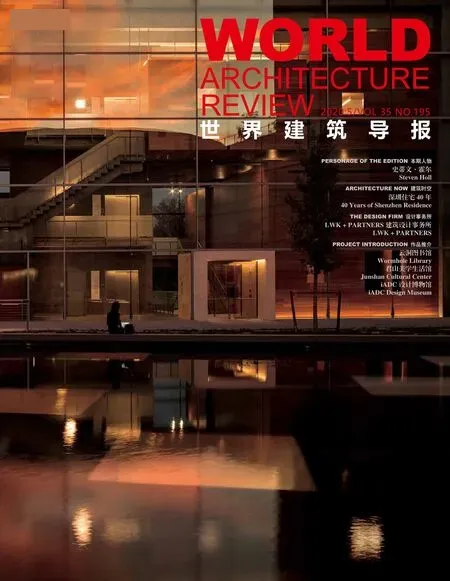未来建筑将以选择为导向
就如艺术逐渐脱离白立方概念,建筑的特定功能也正在悄悄消散。不论是何种类型的建成环境,都似乎正在向“综合用途”的方向发展,而背后的原因同出一辙,就是务求赋予空间使用者更大的主导权,让他们根据个人生活方式、到访目的和社交需要,选择如何游走、如何使用,以带来综合、多元化的空间体验。这些具启发性、能诱使人们投入其中的建筑空间,正如LWK + PARTNERS 一直相信的,好的设计能为人们创造可能性,同时对他们的生活给予正面的影响。
综合用途:赋予人们主导权
“体验”是一种当代特有的商品。虽然电子商贸似乎大行其道,但生活中尚有千百种需求需要人们亲身参与和感受。当消费成为一个过程而非最终目的,商场运营商也开始寻求提供更多元化的空间,例如举办工作坊、艺术展览或与商户合办特别活动等;同时越来越多零售商将其品牌打造成“生活风格品牌”,透过提供满足生活各方面的配套产品,涵盖衣服、饰品、文具以至家具、电子产品及食品等等,从生活各个层面帮助顾客体现他们心目中的理想自我。
购物中心倾向透过 “浸入式”设计,精心策划顾客体验。以 LWK + PARTNERS 设计的中国华山西环宇城为例,项目灵活运用室内外空间,通过“花见”、“云见”、“泉见”、“林见”四景,串连商业空间及室外景观,为访客提供一个置身山水之中的游历式休闲体验。零售设计师采用实体和数字工具,从视觉、听觉、触觉、气味、情感等等多方面的感官刺激,规划以探索、社交和知识为重心的商业空间,连系人、地方和社区。
中国华山西环宇城旨在塑造一个都市中的现代桃花源及社区热点,设计提炼华山、鹊山的巍峨轮廓,转化成层叠交错的建筑体量,延续附近一带的自然环境,丰富视觉享受,同时创造社交互动和空间转换的体验。该项目展示了一个地方如何吸引人们到访发掘生活新点子,甚至与亲友分享到访体验。
人们将社区生活带入零售环境已经好一段日子,零售环境早已成为“第三空间”。但随着第一空间(家庭)和第二空间(工作)基本重叠,他们正在超越“第三空间”的时代。工作人脉与个人领域特别在近年开始相互交织,与人见面和相处的重要性日益增加。
因此,零售环境的本质已演变成不仅仅是交易场所,而是一个与其他人见面和分享的地方。包括艺术文化、娱乐、学习和社交聚会在内的各种社交需求,都在一个连续空间中紧密相连。商业空间的定义不断转变,对租户类型也产生了巨大影响:商场租务人员不断调整商户组合,以满足顾客各方面的期望,但空间始终有限,为了适应转变,逐渐演变出一种多元共存的城市空间。
为了提供足够的灵活性,让使用者自主安排自己的空间体验,LWK + PARTNERS不断钻研动线设计。提高空间的透明度成为了增加选择权的一种手段。近期开张和即将开张的零售综合体展示出一种扩大访客视野的趋势。不论是在同一楼层或跨楼层来说,提高可视性能够给予访客一个更佳的空间概念,让他们更清楚眼前选择的多样性,以决定用何种节奏游走及探索。
另一个 LWK + PARTNERS 项目中国成都西宸天街提供开放通透且高可达性的空间,贯通人、社区和自然环境。多首层式设计让访客从不同楼层进入购物中心,带动人流到较高楼层,同时将购物中心自然融入周边社区,模糊两者的边界。购物中心的主入口拥有最佳视点,可以仰望大部份的零售楼层,而紧凑相通的人流动线则为顾客提供充裕的弹性,让他们创造独一无二的购物体验。
创新型枢纽:未来办公趋势
都市人每天约有三分之一的时间花在工作上,而工作本身却与生活的其他部分越见融合。LWK + PARTNRES 发现随着斜杠一族和自由工作者在年轻一代中渐成趋势,社会需求也会随之变化,反映价值观、人们重视的事情和生活方式一直在变。
员工的生产力及健康质量息息相关。尤其在今天的亚洲,企业高管意识到矽谷模式的优势,并在此基础上投资,按照场地需要和在地文化打造创新型枢纽办公建筑。这现象已陆续扩展到高科技领域以外的行业。这些新型综合体涵盖了生活中不同元素,鼓励工作生活平衡,营造出一种有助创新、互动和建立归属感的办公环境。
中国杭州镓谷科学园提出一种新型的“园林办公”发展模式,公共空间渗透多个楼层,包括位于三层的环型空中平台,连接餐厅、空中花园及其他康乐设施。LWK +PARTNERS设计团队特意把较高层建筑外壳做了大笔切割,创造公共阳台空间,并大量引入自然风和阳光。
在理念上,创新型枢纽的办公设计须提供相应硬件以及增值设施,以创建出符合综合用途的 “行动平台”,鼓励人们自主开拓各种空间可能性。随着移动文化兴起,几乎任何地方都可以成为办公场所,而同时必须满足生活中的其他需求。别说咖啡店早已发展成兼容各种数字设备的共享办公空间,办公空间也正蜕变成富趣味性、启发性和多元性的混合空间,满足员工的健康、心灵和社交所需,提供各种餐饮、康乐设施、公共空间、露天空间,甚至多功能文化艺术表演场地。

香港终审法院大楼 (中环前立法会大楼)
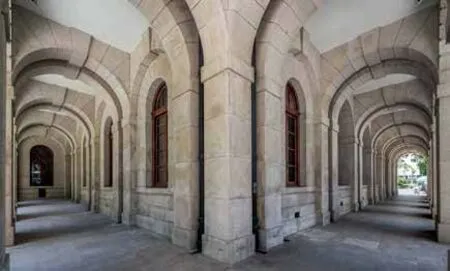
The Court of Final Appeal (Former Legislative Council Building), Hong Kong, China
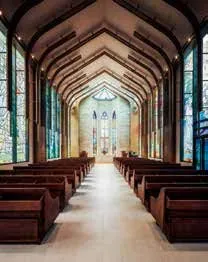
重庆长嘉汇弹子石老街一德堂Yide Catholic Church at Landmark Riverside Danzishi Old Street, Chongqing, China
与人接触是人们与生俱来的基本需要,而LWK + PARTNERS作为建筑师及城市设计师正对之重新审视,并通过开放布局、连续空间和多方向动线设计,使偶遇和亲身对话变得更加容易。
世界无边 体验无间
“边界”将会从未来城市逐渐消失,各种功能场所相互融合,形成一个连续的共享空间。建筑和城市设计的“地标性”不再依托标志性的外型,而是源于建筑空间所能激发的是社区活力和创造潜能。
在不久的将来,高度包容性和弹性将会是成功建筑的必备元素。空间通透度成为促进共存的途径。开放式办公室也成为一种管理手段,用以提高员工的工作效率和沟通互动,同时激励团队动力和培养归属感。这种模糊边界的趋势也早已蔓延到零售业,宽广的店面倾向与外部空间衔接,甚或直接把墙面去掉。
随着综合空间风行,开放空间和园林绿植成为了不同功能区域的自然黏合剂,但不止是纯粹的过度空间,同时赋予这些公共区域具有真正意义和趣味。引入不同品种的花草树木、各类水体、有趣的公共家具和艺术品等等,都能促进社交互动或提供一点生活喘息空间。若进一步提升至城市规划的层面,随着步行文化成为其中一项宜居城市指标,公共空间亦有助推广步行文化,鼓励行人自由探索,以清新的生活体验吸引居住人口、劳动力以及企业投资。
室外与室内之间的界线持续模糊,而空间融合也体现在不同层面、不同楼层的建成环境。屋顶花园对办公场所和商业空间来说曾是奢侈品,但随着社会对社交和休闲空间的需求增加,加上越来越多人关注碳足迹,亲自然的建筑设计以各种形式不断渗入功能空间。高层建筑的设计出现切割缺口以引入室外景观,露天庭院从地面向上穿透建筑物多个楼层,而传统上预留给高管人员用作角落办公室的楼面空间也逐渐被公共阳台取替。
以中国杭州奥体万科中心为例,LWK + PARTNERS 通过引入不同形态的公共空间,开拓人与人之间的交流机会。其商业裙楼由层递式开放平台包裹着,设计上透过逐层旋转,令每层的开放程度各异。加上空中花园以及“侵蚀”各层楼面的特色绿化空间,让上班族及访客更容易透过交谈开拓人脉。
在世界各大城市,场地与周遭社区之间的边界也正被抹除。建筑物的出入口被建在不同楼层、不同形式:位于地面的敞开式入口、地下铁连接口、下沉式广场、平台入口等等,统统都可能成为访客进出建筑的地方。
这些转变最终将会达致连绵无边界的城市景观、流动的城市肌理,提高生活中的自由选择弹性。综合型设计的创新型枢纽和生活综合体将让多样化的价值观共同发展,大幅改变今天的社区面貌。同时,以用家选择为导向的设计理念也将从个别项目扩展到城市规划。
制度变迁
公共及功能建筑不再以单一标准化的开发模式为主调。学校、医院、政府大楼、市政厅及历史遗迹之类设施的性质,过去总被视为以便利运营为主,而不是以服务居民的真实需求为面向。但随着社会价值观倾向尊重自由选择的文化,公共机构和服务运营商越来越重视用家体验。
教育对个人成长和发展影响深远,学校作为其中重要场所,正面临一股新的教学风气。现今教育模式鼓励学生制定自己的学习计划,学校倾向提供一个鼓励探索、拥抱多元、灵活的教学环境。LWK + PARTNERS 在其教育设计结合这种新的框架,以鼓励主动学习、创意和互动。
有见学校运营商及办学机构希望促进学生、教师及其他使用者之间的交流,LWK +PARTNERS正在做出更大胆的尝试,包括更重视装饰细节、房间之间和建筑物之间的联系更鲜明、共享空间更宽敞、康乐设施更丰富。设计以帮助诱发年轻人全方位潜能为目标,同时促进教学及非教学人员的工作。
除了校园改革,当今父母亦希望孩子能够通过日常生活中累积不同面向的学习经验,不以校园生活为限。教育元素和儿童友善设施已成为住宅项目、公共场所、街道景观以及商业设施的一部分。
与此同时,随着世界各地人口结构变化,特别是在老龄化经济体,医疗和保健早已受到广泛关注,但今天真正核心的议题却是如何通过设计表达关怀、同理心和联系。从患者、家人,以至医护及其他人员都希望从医养空间中得到充分尊重。
医疗设计涉及复杂思维,而近年这类建筑的氛围变得较为宽容,且对嵌入新技术更为敏感,也倾向加入更多公共空间。这不仅是因为筹资机制发生了变化,还因为人们希望尽量减少孤立感或封闭感,并更愿意接受保健和医院设施为日常社区景观的一部分。未来的医疗保健综合体将通过开放式布局、更通透的结构和自然元素的采用,与周围环境进一步融合。
在设计中国石家庄正定新区兆华医院项目时,为营造良好的复康环境,LWK +PARTNERS 采取了“以患者为中心”的方针。项目与传统方盒子式的医院外观不同,以山地丘陵为原型,形成独特的建筑肌理,强调与自然环境结合为一。大量绿化空间及花园亦为患者提供舒适的休息环境。
全新价值
“价值”的概念正经历本质上的变化,并尤见于城市发展和房地产市场的层面上。从资金丰厚的投资者到普罗使用者,只谈经济和货币价值已不能满足这些持分者的需求,他们正转投一些激发多元可能性和支持可持续发展的项目。整体社会对环境、社会及管治(Environment, Social and Governance;ESG)的关注日益提升,意味着投资者和公众都渴求一个更共融、宜居的未来。
未来几年,建筑和城市空间的价值将取决于它能否让人们过上自己喜欢的生活,并兼顾可持续发展。人们的健康质量及社区意识将成为地方营造的重点,私人及公共机构将合作通过以人为本的设计方案,实现社会及环境目标。
特别是在中国,公共交通导向型社区在香港、深圳和成都等城市蓬勃发展,形成以步行距离为尺度的城市体系。LWK + PARTNERS积极参与了这些城市的公共交通导向型社区,对当地及这类型的规划和发展有着深刻理解和经验。随着依赖汽车的预设生活模式转向零碳模式,这些步行主导的社区正好提供先导功能,优先考虑如何善用互联互通的街道网络,让居民自由便捷地步行游走,以理想节奏过日常生活。
优质空间的建设与价值观和生活方式密不可分,后两者均会随着时间不断变化。当代城市态度强调和谐共存、相互尊重和跨领域协作,综合体建筑应运而生。建筑师和设计师作为空间策划人,正陆续将空间自由度归还给使用者。LWK +PARTNERS也正透过一系列灵活元素构建物理环境,并以 “推助”替代 “主宰”为设计主导。 由于“难忘体验” 的定义因人而异,LWK + PARTNERS相信,人们必须参与共同创造体验的过程,才能建立深刻的地方触觉和主导意识,享有更大的生活弹性。
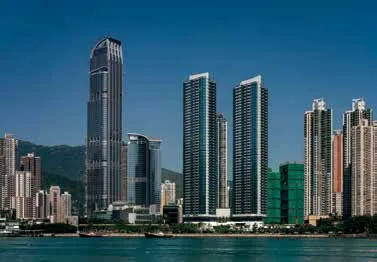
香港柏傲湾 THE PAVILIA BAY, Hong Kong, China
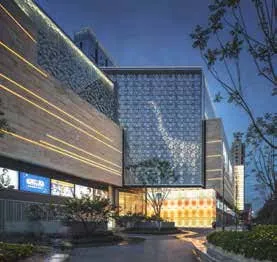
成都西宸天街 Xichen Paradise Walk, Chengdu, China

成都西宸天街Xichen Paradise Walk, Chengdu, China
Architecture is moving away from designated functions just as art is moving out of the white cube.Different types of built environments are converging towards mixeduse programmes and with a common motive: to empower users with greater choice- in terms of how to navigate and utilise the space - for an integrated, diversified experience that is loyal to personal lifestyle, visiting intentions and social needs.These inspiring and engaging architecture creates possibilities to people and gives positive impact to their lives, as LWK + PARTNERS always believes what great design can do.
Mixed-use programmes: letting people take ownership
‘Experience’ is a contemporary merchandise.Despite the rise of e-commerce,there remainsa whole range of demands in life which require physical presence.As consumption becomes a process and not the ultimate goal for customers, mall operators seek to respond to changing consumer behaviours by offering a more diverse programme with special events like workshops, art shows and tenant collaborations,while retailers are turning into ‘lifestyle brands’ that defines people’s way of living as a whole, marketing their products in packages that help customers become the type of people they aspire.From clothes, accessories and stationery to furniture, electronicsand the food you eat, retail has become a medium of self-expression.
Shopping malls are going ‘immersive’ to surround visitors with a curated experience.In LWK + PARTNERS’ project West HuashanUnipark in Jinan, China, an intermingling of outdoor and indoor spaces is strategically deployed to offer an exploratory customer journey that encourages freestyle, multidirectional circulation, together with a series of major attractions themed ‘blossom’, ‘cloud’, ‘spring’ and ‘forest’.By employing a host of physical and digital tools to stimulate the visual, audio, touch, scent, emotional senses and beyond, retail designers focus on elements of exploration, socialising and learning to connect people, places and their communities.
Designed to be a poetic urban retreat and a social hub for the community, West HuashanUniparkfeatures interlocking massing and bronze concave rooflines,extending the beauty of nearby landforms to offer a fully immersive retail environment and catalysing social interactions and movement between spaces.The project demonstrates how a place where people come to discover new, lifeenrichening ideas that they want to share with family and friends after the visit.
People have long made retail environments their ‘third space’ by taking their social life to the retail environment.Theyare now moving beyond the ‘third space’conception as the first space (home) and second space (work) substantially overlapped.Especially in recent years, the need to meet and mingle with people has escalated as work relationships have crisscrossed with personal realms.
The nature of retail environments has therefore evolved into being more than a marketplace, but a place to meet and share experiences with other people.Various components of social needs including arts and culture, entertainment, education and social activities have come together to be well connected in a continual space.People’s changing conception of retail has a huge impact on tenant mix, with leasing managers constantly re-configuring the retail programme to address the variety of customer expectations.In the face of space limitations, the result is often hybrid urban spaces adaptable to change and coexistence.
To grant users ample flexibility to curate their own visiting experience,LWK+PARTNERS looks into new ways of approaching circulation flow.Transparency has become a premium tool to achieving choice.Floor plans of newly opened and upcoming retail-led complexes are showing a trend to expand visual horizons of their visitors.Visibility, in terms of seeing what else are on the same floor and seeing across different levels, gives visitors a good idea of the diversity of choices they have,and allow them to navigate and explore the offerings in their own rhythm.
Chengdu’s Xichen Paradise Walk in China, designed by LWK + PARTNERS, is a great example that provides high transparency and accessibility to bring together people, their neighbourhoods and nature.Multiple ground floors give different points for attracting visitors and a higher accessibility especially to the higher levels, as well as blur the boundaries between the mall and the surrounding neighbourhood to encourage social interaction and community life.The inter-connected circulation enables users with ample flexibility to personalise their visiting experience.
lnnovation hubs: future of work
For us living in the cities, about one third of our daily hours are spent on our jobs,while work itself is increasingly comingled with other quarters of life.While slash careers and freelancing being increasingly popular among the younger generation,LWK + PARTNERS sees the changing needs of society that reflect a shift in values,priorities and the way of life over time.
Productivity is closely tied with employee wellbeing.Corporate leaders, especially in Asia, see the advantages of the Silicon Valley model and are investing to develop tailored, localised models of innovation hubs, a phenomenon that is beginning to extend beyond the technology sectors.These new complexes engulf different dimensions in life to ensure a work-life balance, building an environment that motivates innovation, interaction and a sense of belonging.
In Gallium Valley Science Park in Hangzhou, LWK + PARTNERS proposes a new officepark typology by emphasising shared spaces on multiple levels, with a communal ‘skyloop’ platform connecting office spaces with amenities like eateries, roof gardens and other recreational facilities.Major recesses have also been introduced to the building envelopes to create communal terraces flooded with fresh air and sunlight.
The idea is to provide the necessary hardware plus value-added amenities to craft mixed-use ‘platforms of action’ that encourages users to take over for diverse programmes.With the rise of on-the-go culture, virtually any place can be a workplace while other needs in life must be fulfilled too.While cafes have adaptively evolved into gadget-friendly co-working spots, workspaces are also evolving into exciting, inspiring and hybrid communities that reach out to employees’ health, wellness and social needs, providing a range of food and beverages, recreational facilities, public areas,terraces and multifunctional venues for arts and cultural expression.As architect and urban designer, LWK + PARTNERS has revisited the basic human need to be in touch with other people to make casual encounters and face-to-face conversations easier with open layouts, continual spaces and multidirectional circulations.
Borderless world, continual experience
Cities of the future are a borderless world where functional venues merge into one another to form a continual shared space.Architecture and urban designs will increasingly be recognised not because they are iconic landmarks, but because they are catalysts of social energy and creative potential.The most successful architecture in the coming years will likely be characterised by inclusiveness and versatility.Transparency is now a means to promoting coexistence rather than an objective per se.Open offices have become the tool for boosting work productivity and social interaction as well as motivating staff and nurturing a sense of ownership.This trend has moreover spilled over to retail, with shop fronts inclined to merge with outside space with wide-span shop fronts or doing away with walls altogether.
With mixed-use programmes on the rise, open spaces and greenery may appear to be a ‘stitching tool’ for different functional components, but these common areas can be truly meaningful and engaging rather than pure transitional areas.An interesting curation of botanic species, waterscapes, public furniture and artworks can provide ample opportunities for social interactions or inspire moments of reflections.Taking this to an urban level, public spaces are key to promoting walkability, whichhas become a parameter of liveable cities due to its conduciveness to free navigation,attracting residents, work talent as well as businesses.
Meanwhile, the outdoor-indoor distinction continues to blur, and spatial integration operates on different levels - literally.
Roof-top gardens are once a luxury for workplaces and commercial developments,but as the demand for social and relaxation spaces increase and to cut back carbon footprints, biophilic structures are encroaching functional territories for good, and in a variety of forms.High rises have elevations carved out to give ways for insideout pockets, open-air courtyards penetrate building masses from the ground up connecting different levels, and the parts of the floorplate traditionally reserved for corner offices are now exposed to sunlight.
At Olympic Vanke Centre in Hangzhou, for instance,LWK + PARTNERS seeks to enable people’s interactions through public spaces in various forms.The retail podium will be wrapped by cascading open terraces, with a landscaped void at the centre.Every floor of the podium is slightly rotated to offer a different level of publicness.Together with a roof terrace and distinctive green spaces that ‘erode’ the floor plates, the project looks to create a whole new layer of networking opportunities for office users and visitors.In cities around the world, boundaries between project sites and their surrounding neighbourhoods are further being wiped out.Buildings are increasingly welcoming their visitors through multiple points at different levels from wide-open cut-outs and patios on ground level, underground metro connection, sunken plaza to podium entrances.Ultimately, this will result in an interconnected, borderless cityscape where the urban fabric is fluid and oriented towards the choice of users.Fully integrated innovation hubs and lifestyle complexes are going to transform their neighbourhoods by enabling diverse values to thrive and coexist.It is also a time where the ideal of user-oriented design expands from projects to city-wide programmes.
lnstitutional change
Public and functional developments have ceased to be monotonous.Facilities like schools, hospitals, government offices, city halls and heritage sites used to be perceived as serving operational purposes rather than the authentic needs of individual citizens.But as social values shift towards a choice-oriented culture, authorities as well as service operators are placing far more emphasis on the quality of user experience.
As an influential agency of a person’s formative growth and development, schools are adopting a new teaching and learning approach that encourages students to structure their own learning plans, leading to an inclination towards providing an exploratory environment that embraces diversity and flexibility.LWK + PARTNERS is emerging this new framework of schooling into its educational design with the objective to encourage active learning, creativity and interaction.
School operators and institutions are keen to provide a more interactive space for students, teachers and other users.In response, designers at LWK + PARTNERS are making bolder attempts with special attention to finishing details, more legible connections between rooms and buildings, generous shared spaces and more recreational facilities.All in all, the goal is to help unleash all-round potentials from young people and facilitate the work of teaching and non-teaching staff.While reforms are being carried out on campus, today’s learning experience is not confined to school environments, and more parents are keen to immerse their children in a wealth of learning opportunities in daily life.Elements of education and children-friendly facilities have therefore entered residential estates, public spaces,streetscapes as well as commercial facilities.
As demographic patterns evolve differently across the world, medical and healthcare have surely received their portion of attention, especially in ageing economies.But how their designs express care, empathy and connection has never been as cherished today, where respect is expected to be rendered to all users from patients, carers and staff.
Designing for this sector has come to involve some of the most sophisticated thinking processes, and recent designs have seen a more welcoming vibe, an enhanced readiness for ever-newer technologies and more public spaces.Not only because financing mechanisms have changed, but because people want to minimise the sense of isolation or enclosure and are more willing to include health centres and hospitals as part of the everyday community landscape.The future medical and healthcare complexes will further blend in with their surroundings through open layouts, transparent structures and greater use of natural elements.
To make Shijiazhuang Zhao Hua Hospital Development a convivial place for rehabilitation, LWK + PARTNERS takes a patient-oriented approach to upend the depressive atmosphere traditionally felt at hospitals.It diverges from the usual rectangular form and takes inspiration from mountain landscape, resulting in a distinctive design that creates harmony with nature.There are also ample green areas and gardens to create a comfortable environment for patients.
New values
‘Value’ as a concept is changing, and this is especially true for urban development and in the real estate market.Economic and monetary values are not enough to satisfy stakeholders from wealthy investors to everyday users, who are turning to projects that encourage possibilities and sustainability.The rise of environmental,social and governance (ESG) concerns means that both investors and the public are demanding a more inclusive and liveable future.
In the coming years, the value of architecture and urban spaces will be defined by how well it enables users to live the life they prefer, and sustainably too.People’s wellbeing and their sense of community will be the focus of placemaking efforts,with private and public entities collaborating to achieve social and environmental objectives through human-centric design solutions.
In China especially, transit-oriented communities have flourished in cities like Hong Kong, Shenzhen and Chengdu where LWK + PARTNERS have been involved in creating many of them,forming urban systems within a walkable distance to make daily lives efficient and easier to plan.As contemporary society calls for a long-term change from an auto-dependent culture to a carbon-free one, these walkable communities have acted as pioneers where priorities are given to an interconnected street network where users would freely navigate their daily lives within a convenient distance.
Quality space is inseparable from values and lifestyles, which are constantly changing over time.Today’s urban attitude is underlined by an emphasis on coexistence, mutual respect and interdisciplinary collaboration - a set of principles likely to be materialised through mixed-use programmes.As curators of space,architects and designers are giving choice back to the users.LWK + PARTNERS is now facilitating,instead of dictating, to structure a built environment with a flexible array of elements.Given the fluidity of what makes a memorable experience, letting users co-create their own experience would encourage a stronger sense of place and ownership, all serving a common goal to let people live the lives they aspire.
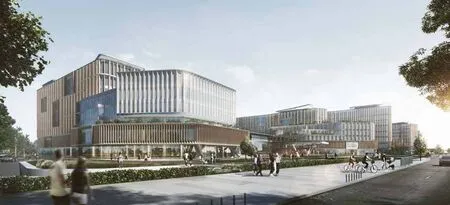
中国石家庄正定新区兆华医院项目 Shijiazhuang Zhao Hua Hospital Development, Shijiazhuang, China

